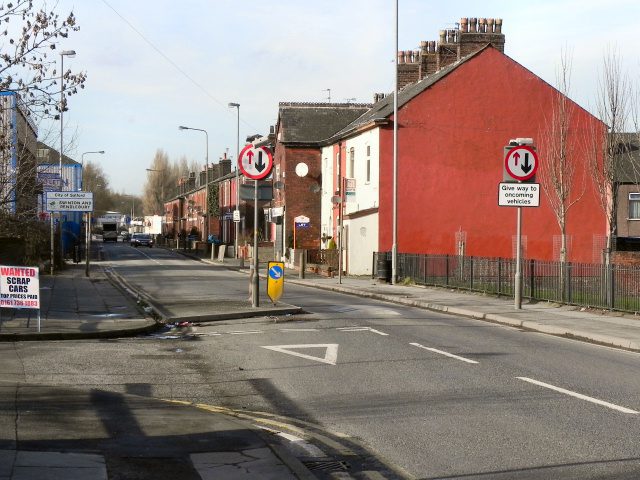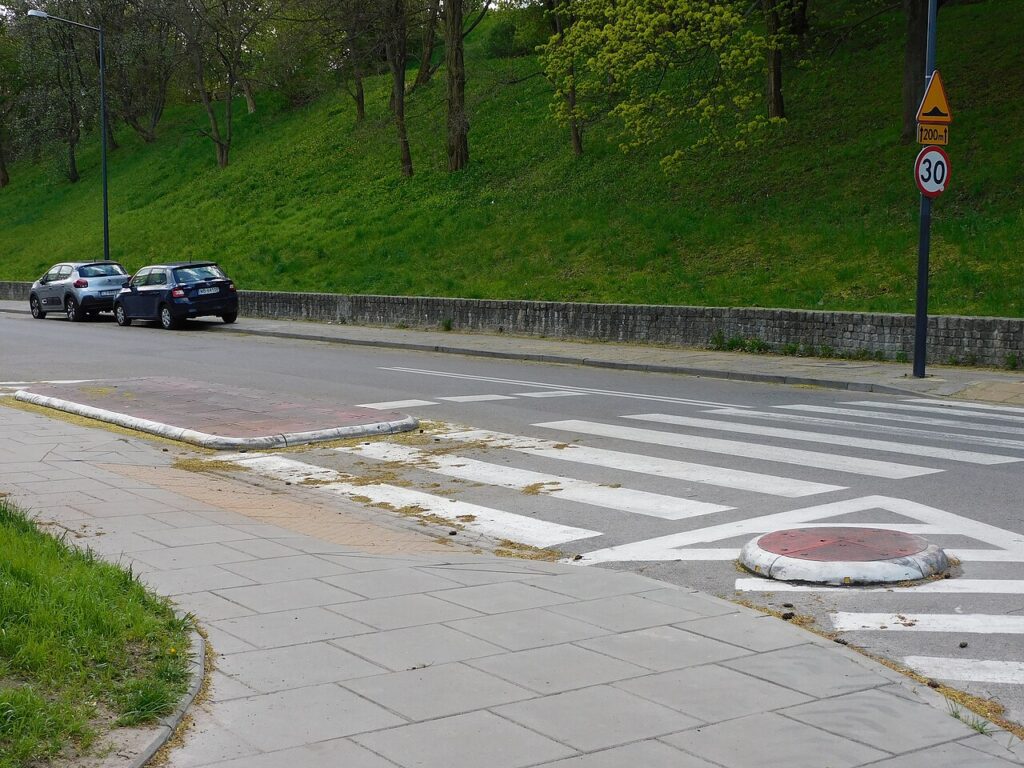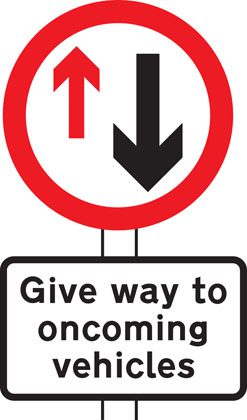
In the UK, with over 30 million cars licensed for use, roads can get extremely busy. This increases the likelihood of people driving at excessive speeds and, consequently, the risk of accidents.
To address this issue, the government has implemented various traffic calming measures aimed at modifying driver behaviour and reducing vehicle speeds.
One such measure is the chicane, a form of lane narrowing that interrupts the usual flow of traffic, often leading to the creation of a single-file lane.
Understanding how to navigate priority chicanes is crucial, as you may encounter questions about them in your theory test or face them during your practical driving test.
It’s important to gain confidence in dealing with these features early in your driving education.
What Does Chicane Mean?
The Origin of Chicane
The term chicane originates from the French word meaning ‘to create difficulties’. In the context of driving, it refers to the use of physical obstacles to alter and manage the flow of traffic, encouraging safer driving practices by necessitating reduced speeds.

Types of Chicanes
Chicanes can broadly be categorised into two types, each serving a specific purpose in traffic management:
Single-Lane Working Chicanes
These chicanes transform a two-way road into a single lane, granting vehicles travelling in one direction priority over those from the opposite direction.
This type effectively manages the flow of traffic, ensuring smoother and safer passage in busy or residential areas.
Two-Way Working Chicanes
Two-way working chicanes are designed to narrow certain points along the road while still allowing for the flow of traffic in both directions.
This setup helps in slowing down vehicles and enhancing the safety of both drivers and pedestrians without significantly disrupting traffic movement.
Implementation and Purpose
Chicanes are often installed in pairs or groups, with priority alternated between the two directions of traffic.
This strategy ensures that no single direction faces excessive delays, yet effectively reduces overall speed and enhances safety on the road.
The balanced approach of chicanes plays a crucial role in traffic calming, particularly in areas where pedestrian safety and noise reduction are important considerations.
Understanding and navigating chicanes is an essential skill for drivers, contributing to a more mindful and safer driving environment.
What Do Chicanes Look Like?
Identifying Chicanes
Understanding the appearance of chicanes is crucial for navigating them effectively and ensuring a smooth driving experience.
Chicanes are man-made structures, typically characterised by a raised island or a build-out, which is placed horizontally across the road. Their design serves as a physical obstacle that drivers must navigate around.

The Appearance and Purpose of Chicanes
The primary purpose of a chicane is to slow down traffic by requiring drivers to alter their path. This is achieved through the strategic placement of these obstacles, which compels drivers to reduce their speed to safely manoeuvre around the chicane, similar to the way one would navigate around a parked car on the road.
By recognising and understanding the structure and intention behind chicanes, drivers can approach them with greater confidence and care, contributing to safer road conditions for everyone.
Understanding the Theory of Chicanes
The Purpose of Chicanes
It’s vital to grasp the purpose of chicanes and their role in traffic management. Chicanes are designed to reduce vehicle speed as part of broader traffic calming measures.
This understanding is crucial, especially as you might be questioned on this topic during your theory test. The test not only assesses your knowledge of chicanes but also your ability to recognise road signs and markings associated with them.
Chicane Road Signs
While chicane road signs may not always be present, there are two main types you should be familiar with, which vary depending on your direction of travel:
Signs Indicating Priority
When you have priority, you’ll encounter a blue and rectangular sign. This sign features two arrows: one pointing upwards, in your direction, and another pointing downwards, indicating vehicles coming from the opposite direction. The larger arrow pointing towards you signifies that you have priority.

Image source: Open Government Licence v3.0
Signs Where You Do Not Have Priority
Conversely, when you do not have priority, you’ll see a circular sign with a red outline. This is a prohibition sign indicating that you must not assume priority.

Image source: Open Government Licence v3.0
Instead, you should give way to oncoming traffic, as denoted by the larger arrow facing towards you.
It’s important to be able to identify these signs visually, even though they may sometimes be accompanied by explanatory text.
Chicane Road Markings
In areas where you do not have priority, dotted white lines on the road indicate Give Way markings. These are placed before the road narrows and signal where you should stop and assess the situation.
If there is oncoming traffic already navigating through the chicane, they have priority. Therefore, you must stop before these markings, allowing the oncoming traffic to pass safely.
Understanding these signs and markings is essential for safe driving, particularly in areas where chicanes are used to manage traffic flow and speed.
Guide to Driving Through Chicanes
Understanding the Highway Code on Chicanes
The Highway Code addresses chicanes and other traffic calming measures, such as road humps, in Rule 153.
It advises drivers to reduce their speed as they approach a chicane and to maintain this lower speed until they have safely navigated through. Drivers are recommended to proceed in single file through the chicane and to avoid overtaking.
The Code also highlights the importance of being vigilant for cyclists and motorcyclists, who may require additional space to pass through or may be able to bypass the chicane entirely.
When it comes to priority rules, having priority does not guarantee an absolute right of way. It implies that, under normal circumstances, you should proceed first.
However, it’s critical to observe if vehicles are already navigating through the chicane towards you. If the space is too tight, it’s safer to wait your turn rather than forcing your way through.
The absence of road markings means drivers must use their judgement to decide when it’s safe to proceed, considering the space needed by oncoming traffic.
Approaching Chicanes with Caution
Navigating through chicanes requires a slow and steady approach, akin to entering a roundabout. Once there’s a safe opportunity, proceed with caution, bearing in mind that the road will be narrower than usual.
This situation demands excellent clutch control, especially when starting from a standstill, to ensure smooth and safe passage through the chicane.
Learning to drive through chicanes with confidence is an essential skill, contributing to safer driving practices.
For those seeking additional guidance, professional driving instructors can offer tailored advice and training to enhance your driving abilities in these and other traffic situations.
Frequently asked questions
Chicanes represent just a single method within a broader array of traffic calming measures designed to encourage drivers to reduce their speed on specific roads.
Other strategies include speed bumps (sometimes referred to as speed humps or sleeping policemen), various types of narrowings, speed cameras, and rumble devices.
Each of these measures serves to either physically limit the speed of vehicles or to encourage drivers to voluntarily slow down.
On racetracks, chicanes are used for a similar purpose as they are on ordinary roads: to reduce speed.
These are essentially ‘S’ bends strategically positioned on or immediately following long straight sections of a track.
This placement is deliberate, as it is where vehicles are likely to accelerate to potentially unsafe speeds.
The introduction of chicanes helps in managing these speeds, ensuring a safer racing environment.
Priority chicanes are predominantly situated in residential areas, where maintaining a low and controlled speed is particularly crucial.
These areas are frequented by vulnerable road users, including pedestrians who may use the chicane islands as crossing points.
It’s important to remain vigilant and adjust your speed accordingly to ensure the safety of all road users in these environments.


